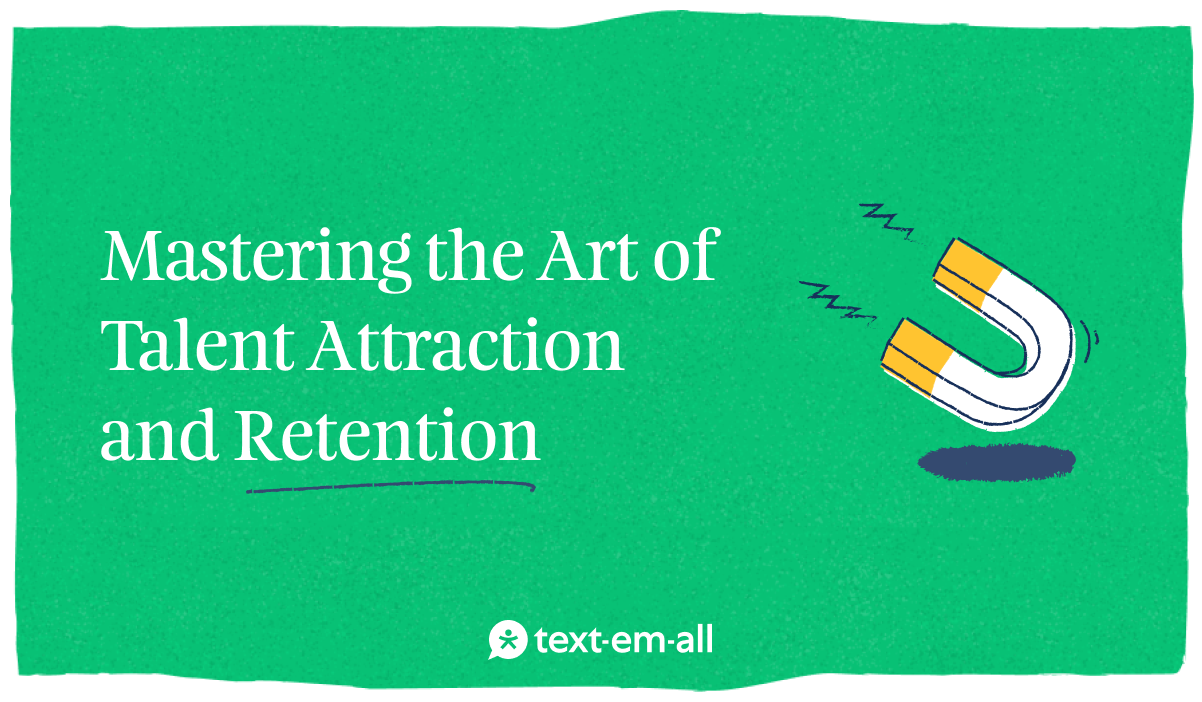
One of the most important skills to have in today’s business world is the ability to attract and retain top talent. Organizations that excel in these areas often enjoy higher productivity and innovation and foster a positive company culture that becomes a magnet for potential applicants.
In this blog post, we’ll distinguish between talent acquisition and attraction, discuss the importance of attracting and retaining talented employees, and explore effective mass text messaging techniques.
Table of Contents
- Talent Acquisition vs. Talent Attraction
- The Importance of Talent Attraction and Retention
- Current Work Culture Trends and Expectations
- 4 Ways to Use SMS for Talent Attraction
- 4 Ways to Use SMS for Talent Retention
Talent Acquisition vs. Talent Attraction
In human resources, two essential components shape the workforce: talent acquisition and attraction. While these terms may seem interchangeable, they represent distinct phases in building a robust and skilled team. Since we’ll be focusing on talent attraction, let’s briefly touch on the difference between these terms.
Talent Acquisition
The primary goal of talent acquisition is to fulfill immediate staffing needs efficiently. It encompasses the entire recruitment lifecycle, from creating job descriptions and posting openings to extending job offers. While talent acquisition is a crucial element of workforce planning, it tends to be more transactional, focusing on filling open positions quickly.
Talent Attraction
On the other hand, talent attraction is a proactive and strategic approach to creating an appealing employer brand that entices skilled and impressive candidates. Unlike talent acquisition, which reacts to immediate hiring needs, talent attraction is an ongoing effort to position the organization as an employer of choice.
Talent attraction involves nurturing a positive employer brand that extends beyond job listings. It aims to create a magnetic pull with people wanting to work for the company even before specific roles are open. This process includes showcasing the company's culture, values, and growth opportunities, often through social media, networking events, and other branding initiatives.
The goal is both to fill existing positions and build a pipeline of interested and qualified candidates who align with the company's long-term vision. It's about fostering a positive reputation that excites individuals about the prospect of working for your organization.
The Importance of Talent Attraction and Retention
Employees are a company's most valuable asset, which makes attracting and retaining top talent both an HR function and a strategic necessity.
Here are some ways talent attraction and retention can affect a company’s workforce.
Productivity
- A skilled and diverse workforce creates an environment where teams can collaborate effectively. The different skill sets allow the team to be creative and solve problems efficiently.
- Engaged employees actively enhance and streamline existing processes and workflows.
- Employees focused on professional development increase the organization's adaptability to industry changes and fuel sustainable growth.
Creativity and Innovation
- A diverse talent pool brings varied perspectives and experiences, fueling a dynamic environment that encourages creative thinking.
- Engaged employees are more likely to actively participate in brainstorming sessions, contributing to creative problem-solving and strategic thinking.
- In sum, maximizing organizational impact through talent goes beyond individual contributions—it creates a ripple effect that influences team dynamics and organizational efficiency, ultimately shaping the company's overall success.
Current Work Culture Trends and Expectations
Organizations must adapt their talent strategies to meet evolving expectations as the workforce undergoes significant shifts influenced by remote work, a heightened focus on work-life balance, and increased attention to corporate social responsibility (CSR). Highlight (or consider adopting) these highly sought-after aspects of your business:
Remote Work
- Showcase or offer flexible work arrangements, including remote work options, to accommodate the growing preference for a work-from-anywhere culture.
- Implement technologies that facilitate seamless collaboration and communication for remote teams.
Work-Life Balance
- Promote policies prioritizing work-life balance, such as clear guidelines on working hours and encouraging employees to take regular breaks.
- Communicate the organization's commitment to supporting a healthy work-life balance through internal channels and recruitment materials.
Corporate Social Responsibility (CSR)
- Showcase CSR initiatives prominently on the company website, social media, and recruitment materials to demonstrate a commitment to positively impacting society.
- Involve employees in CSR activities, fostering a sense of purpose and community engagement.
Flexible Benefits Packages
- Tailor benefits packages to cater to individual needs, allowing employees to choose benefits that align with their preferences, such as wellness programs or additional vacation days.
Diversity and Inclusion Initiatives
- Communicate diversity and inclusion initiatives to create an inclusive workplace that values and respects individual differences.
- Actively participate in industry-wide diversity programs and events to reinforce the organization's commitment to diversity.
Professional Growth Opportunities
- Provide ongoing training and development opportunities to empower employees and support their professional growth.
- Communicate the organization's dedication to employee development through regular updates and recognition of career advancements within the company.
Employee Well-Being Programs
- Establish and remind employees of well-being programs focusing on mental health, stress management, and overall employee wellness.
- Utilize internal communication channels, including SMS, newsletters and company-wide meetings, to promote and encourage participation in well-being programs.
Transparent Communication
- Foster a culture of transparent communication by regularly updating employees on organizational changes, successes, and future plans.
- To keep employees informed and engaged, utilize various communication channels, including company intranet, text, and newsletters.
Adaptive Performance Reviews
- Rethink and adapt performance review processes to align with the evolving work culture, emphasizing goals related to remote collaboration, adaptability, and contributions to CSR initiatives.
Employee Feedback Mechanisms
- Establish regular feedback mechanisms to gather insights on employee experiences, concerns, and suggestions.
- Act on feedback to show employees that their opinions are valued and that the organization is responsive to their needs.
By implementing and highlighting these assets, organizations can attract top talent and foster a work environment that aligns with the expectations and values of the modern workforce. Plus, this proactive approach positions the organization as an employer of choice in the ever-changing landscape of work culture.
4 Ways to Use SMS for Talent Attraction
One of the best ways to get the attention of qualified candidates is through mass texting. While texting may not have been the most professional way to reach out to applicants or employees in the past, it’s now recognized as a great way to reach your contacts.
With SMS, employers can craft concise yet impactful messages to communicate key aspects of the employer brand – for example, the company’s unique value as an employer, competitive compensation, preferred working conditions, and seamless hiring processes. Here’s what this would look like in practice:
1. Employer Branding
Create a compelling narrative around what makes the organization unique, its values, and the opportunities it provides for professional growth. Leverage social media, company websites, and employee testimonials to showcase the organization's unique appeal.
For example:
"Join [Company Name] - Where Innovation Meets Purpose. Explore exciting opportunities with us!"
2. Competitive Compensation Packages
Offering competitive salaries and benefits is a fundamental aspect of attracting top talent. Clearly communicate the value of the compensation package in your messaging to highlight the financial rewards of joining your organization.
SMS Template:
"[Company Name] offers competitive salaries and enticing benefits. Let's discuss how your skills align with our rewarding opportunities."
3. Flexible Working Conditions
With the increasing demand for flexibility, organizations should highlight their commitment to work-life balance. Use SMS to convey the flexibility of work arrangements, emphasizing remote work options or flexible schedules.
SMS Template:
"Work on your terms with [Company Name]. Discover the freedom of flexible schedules and remote work. Join us in redefining work-life balance."
4. Strong Recruitment Process
Ensure a seamless and positive recruitment experience for candidates. Provide timely and constructive feedback, keeping potential hires informed throughout the process. Craft SMS messages that convey professionalism and warmth to enhance the candidate experience.
SMS Template:
"Exciting news! Your application with [Company Name] is progressing well. We appreciate your talent and are eager to discuss the next steps. Stay tuned!"
4 Ways to Use SMS for Talent Retention
Using mass texting shouldn’t be limited to just the hiring process. Employers should use text throughout an employee’s time at the company to increase their chances of an engaged employee who sticks around.
An SMS talent retention strategy may include general engagement messaging, professional development updates, recognition texts, and company culture messaging. Here’s what this could look like in practice:
1. Employee Engagement Programs
Employee engagement is a cornerstone of talent retention. Implement programs that foster a sense of belonging and engagement among employees. Use SMS to communicate upcoming engagement events, surveys, or initiatives, keeping employees informed and involved.
SMS Template:
"Your voice matters at [Company Name]. Share your insights in our upcoming employee survey and help shape our journey together. Stay engaged, stay valued."
2. Professional Development Opportunities
Invest in the growth and development of employees by offering training and career advancement opportunities. Use SMS to notify employees of available courses, workshops, or mentorship programs, showcasing the company's commitment to their professional development.
SMS Template:
"Empower your career with [Company Name]. Exciting new learning opportunities await you. Check your inbox for details on our latest professional development programs."
3. Recognition and Reward Systems
Establish a culture of recognition and appreciation. Use SMS to promptly acknowledge and celebrate employees' achievements, reinforcing a positive and motivating work environment.
SMS Template:
"Congratulations! Your dedication hasn't gone unnoticed. You're a valuable part of the [Company Name] success story. Cheers to more milestones together!"
4. Positive Company Culture
Nurturing a positive company culture that values diversity, inclusivity, and a collaborative spirit is instrumental in retaining top talent. Use SMS to reinforce cultural messages, share success stories, and promote a sense of unity among employees.
SMS Template:
"At [Company Name], diversity is our strength. Celebrate the uniqueness each team member brings to the table. Together, we thrive!"
Read Six Best Practices for Text Messaging Staffing Candidates
Balancing Talent Attraction and Retention
Recognizing the symbiotic relationship between talent attraction and retention is crucial for building a sustainable workforce. Attracting top talent is only the first step; retaining that talent requires ongoing efforts to create a workplace where employees feel valued, engaged, and motivated.
By understanding the evolving expectations of the workforce, distinguishing between acquisition and attraction, and implementing effective techniques, organizations can create a talent strategy that propels them to success.
As you reflect on your current talent practices, consider integrating Text-Em-All into your communication strategy to convey key messages efficiently and maintain a personalized connection with potential and existing employees. Create a free account and discover why more companies are using SMS to revolutionize their hiring and retention strategies.












